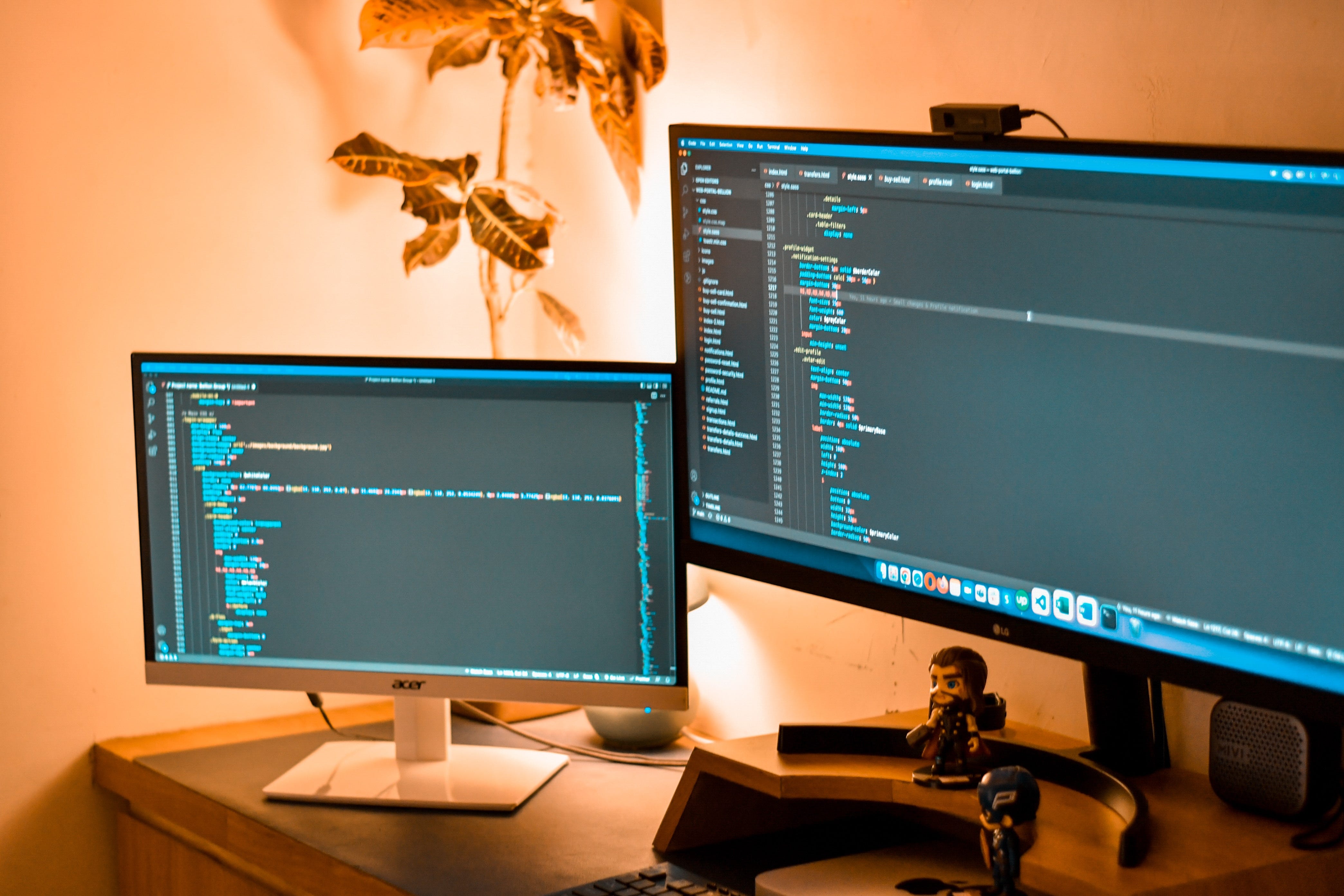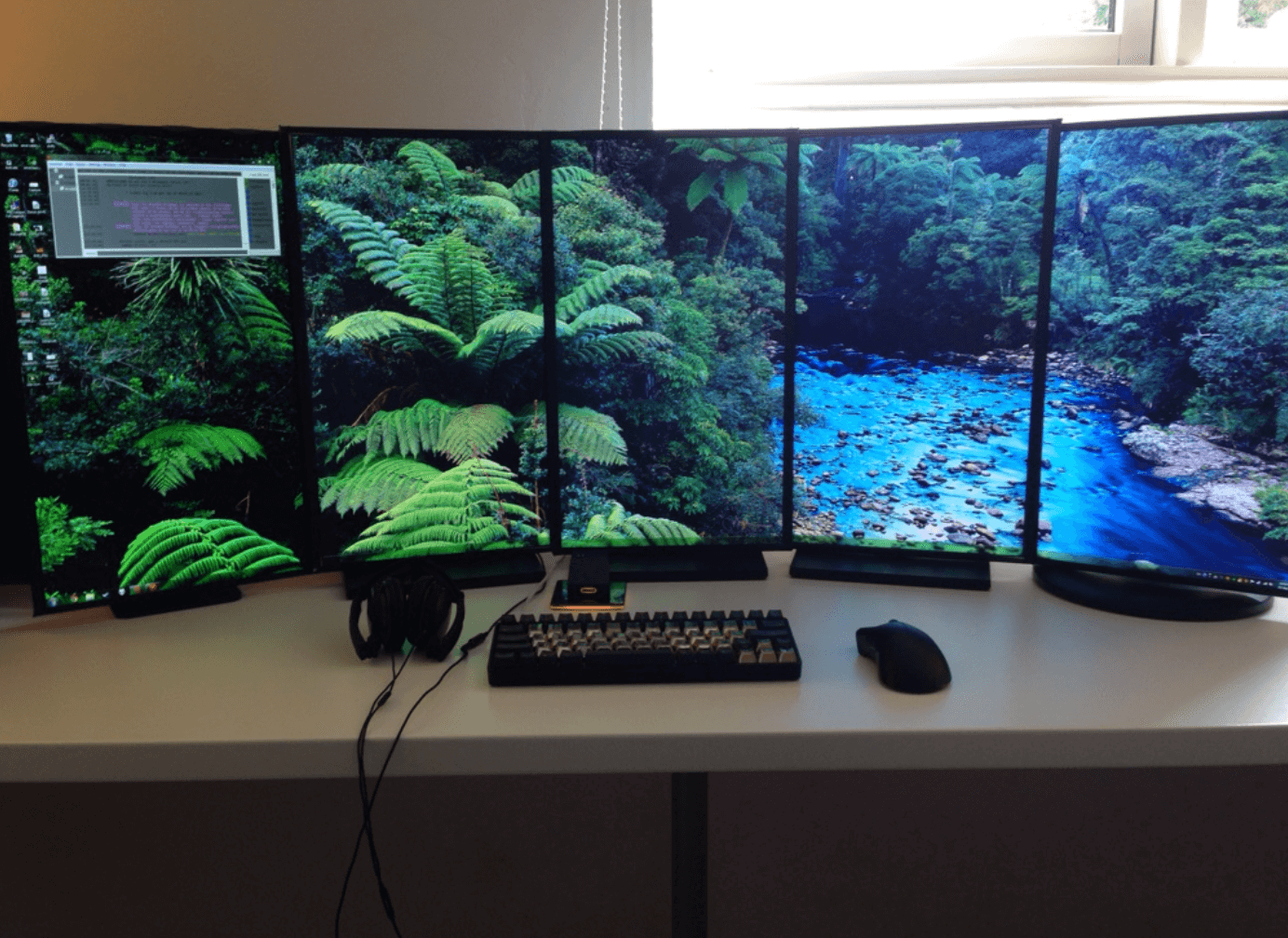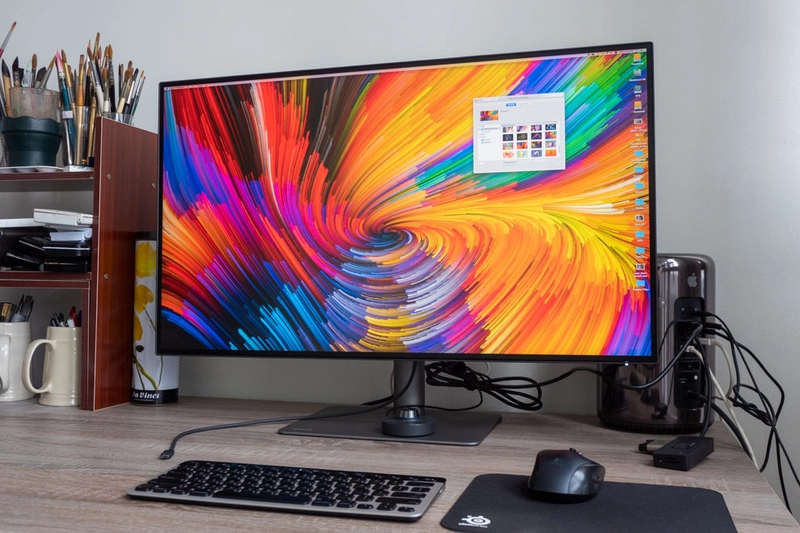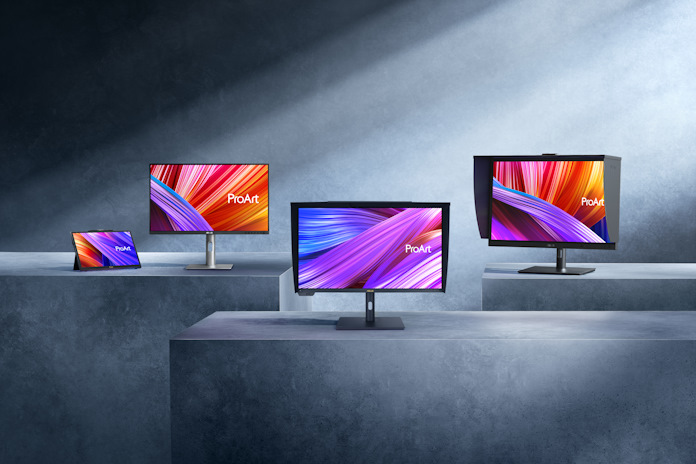Best Vertical Monitor for Programmers – Boost Your Coding Efficiency
If you’re searching for the best vertical monitor for programmers, look no further. In today’s fast-paced digital world, vertical monitors have emerged as a game-changer for developers, offering enhanced readability, reduced eye strain, and seamless multitasking capabilities. This guide dives deep into top options for 2025, helping you select a monitor that aligns perfectly with your coding needs, whether you’re working on long scripts or debugging complex code. From what is a vertical monitor to practical setup tips, we’ll explore how these displays can elevate your productivity and comfort, making them an essential tool for any programmer’s arsenal.
Introduction to Vertical Monitors and Their Relevance for Programmers

Vertical monitors represent a significant shift in display technology, tailored for users who demand more from their screens. These monitors, often pivoted to a portrait orientation, provide a taller viewing area that mimics the natural flow of code and documents, making them particularly appealing for programmers. In an era where coding sessions can stretch for hours, the right monitor isn’t just about sharp visuals—it’s about fostering a workspace that promotes focus and minimizes fatigue. As we delve into this topic, you’ll discover why the best vertical monitor for programmers can transform your daily workflow, turning endless scrolling into efficient navigation and boosting overall output.
What Is a Vertical Monitor?
A vertical monitor, at its core, is a display that can be rotated to a portrait orientation, typically from the standard landscape setup. This design flips the traditional 16:9 aspect ratio to something like 9:16, allowing for a taller screen that aligns more naturally with vertical content such as code files or web pages. Unlike conventional monitors, which spread content wide, vertical models maximize height to show more lines of text at once, reducing the need for constant scrolling. This feature is especially beneficial in programming environments where code blocks can run into hundreds of lines.
For programmers, understanding what is a vertical monitor goes beyond its physical setup; it’s about how it integrates into daily tasks. The pivot mechanism, often supported by VESA mounts, enables quick switches between orientations, offering flexibility for various workflows. According to industry insights, vertical monitors can display up to 50-70% more vertical content compared to landscape screens of the same size, which directly translates to fewer interruptions during coding sessions. This design not only enhances immersion but also supports ergonomic health by encouraging a more natural viewing angle.
Moreover, the rise of remote work has amplified the popularity of vertical monitors, as they adapt seamlessly to home setups. Programmers often pair these with tools like IDEs (Integrated Development Environments) where long-form code is the norm. By providing a canvas that mirrors the structure of programming languages, vertical monitors help in maintaining context, which is crucial for debugging and collaboration. If you’re exploring options, the best vertical monitor for programmers will likely include features like adjustable stands for easy rotation, ensuring your setup evolves with your needs.
Benefits of Using a Vertical Monitor for Programming
One of the primary benefits of vertical monitor use for programming is the dramatic improvement in readability. With more vertical space, programmers can view entire functions or classes without scrolling, allowing for quicker comprehension and fewer errors. This vertical layout reduces cognitive load, as eyes can scan top-to-bottom more naturally, mimicking how code is written and read. In practice, this means less time flipping between files and more time focused on problem-solving, ultimately leading to higher efficiency.
Beyond readability, vertical monitors contribute significantly to physical health by minimizing neck strain. Traditional horizontal screens often force users to tilt their heads or shift positions frequently, which can lead to discomfort over long periods. A vertical setup aligns better with the downward gaze typical in coding, promoting a more ergonomic posture. Studies suggest that proper monitor orientation can reduce musculoskeletal issues by up to 30%, making it a worthwhile investment for programmers who spend extended hours at their desks.
Additionally, the benefits of vertical monitor extend to workflow efficiency, enabling seamless multitasking. Programmers can keep code editors on the main screen while referencing documentation, chat windows, or tools like GitHub on the same display without overlap. This setup fosters a cleaner workspace, reducing visual clutter and distractions that often derail focus. For those in collaborative environments, vertical monitors facilitate real-time code reviews, where multiple lines can be shared and discussed without the limitations of a wide screen.
Why Programmers Prefer Vertical Screens
Programmers gravitate towards vertical screens because they facilitate effortless code review and navigation. In languages like Python or JavaScript, where functions span multiple lines, a vertical monitor allows visibility of context without constant panning. This preference stems from the ability to maintain “flow state,” where interruptions are minimized, and productivity soars. Many developers report that switching to a vertical setup has cut their debugging time by enhancing their ability to spot patterns and errors at a glance.
The appeal of vertical screens also lies in their superiority for multitasking. Programmers often juggle terminal windows, browsers, and editors simultaneously, and a taller screen accommodates this without compromising readability. For instance, you could have your primary code file open at full height while keeping a reference guide or stack overflow page visible below. This setup not only boosts efficiency but also supports vertical monitor for coding focus, as it keeps all essential elements in one streamlined view, reducing the mental effort required to switch contexts.
Furthermore, vertical screens align with the evolving demands of modern programming, such as web development and data analysis. Tools like VS Code or Jupyter Notebooks benefit immensely from the extra vertical real estate, allowing for better visualization of outputs and logs. Programmers prefer these screens for their adaptability, as they can pivot back to landscape for design work or presentations, making them versatile tools in a dynamic field.
How Vertical Monitors Improve Coding Focus and Productivity

In the realm of programming, where sustained attention is key, vertical monitors serve as a catalyst for enhanced focus and output. By optimizing the display for the vertical nature of code, these monitors minimize distractions and streamline workflows, allowing developers to immerse themselves fully in their tasks. This section explores how such setups can transform a chaotic coding session into a model of efficiency, ultimately leading to higher quality work and reduced burnout.
Optimizing Screen Real Estate for Long Code Files
Vertical monitors excel at optimizing screen real estate for long code files, providing ample space to display extensive blocks of code without truncation. This means programmers can view 50-100 additional lines compared to a standard landscape monitor, making it easier to navigate complex scripts or algorithms. The result is a more intuitive coding experience, where context is preserved, and jumps between sections become seamless.
For instance, when working on large projects like machine learning models, having more vertical space allows developers to keep variable declarations, functions, and outputs in view simultaneously. This reduces the cognitive switch cost, as users aren’t constantly scrolling or resizing windows. In detailed paragraphs, it’s clear that this optimization not only speeds up development but also enhances error detection, as patterns and bugs become more apparent in a continuous flow.
Moreover, the best 4K vertical monitor options amplify this benefit with their high-resolution capabilities, ensuring that text remains crisp even when zoomed in. Programmers can customize font sizes and layouts to fit their preferences, fostering a personalized environment that promotes sustained productivity. Ultimately, this setup turns screen real estate into a strategic asset, empowering developers to tackle ambitious projects with confidence.
Reducing Visual Clutter and Distractions
A key advantage of vertical monitors is their ability to reduce visual clutter, creating a focused environment that minimizes distractions. By aligning content vertically, programmers can dedicate the screen to essential elements, such as code and tools, without the sprawl of horizontal layouts. This streamlined approach helps maintain vertical monitor for coding focus, as irrelevant notifications or secondary apps can be tucked away or minimized effectively.
In practice, this means less time managing overlapping windows and more time on actual coding. For example, a developer might place their IDE at full height, with a slim panel for commands, keeping the workspace clean and purpose-driven. Over time, this reduction in clutter translates to fewer interruptions, allowing for deeper concentration and faster problem resolution.
Beyond immediate benefits, vertical monitors contribute to long-term focus by supporting better eye tracking. With content presented in a natural top-to-bottom format, eyes move more fluidly, reducing strain and fatigue. This is particularly valuable for marathon coding sessions, where maintaining sharp vision is crucial for accuracy and creativity.
Enhancing Multitasking and Workflow Management
Vertical monitors revolutionize multitasking by enabling effortless management of multiple windows and references. Programmers can stack tools like editors, terminals, and browsers vertically, ensuring that all resources are accessible without losing context. This setup enhances workflow management, as tasks that once required alt-tabbing can now coexist on a single screen.
For instance, during a debugging process, a developer might have error logs at the top, code in the middle, and documentation at the bottom, allowing for quick cross-referencing. This level of organization not only boosts efficiency but also supports collaborative efforts, where team members can share screens with minimal confusion.
Additionally, the integration of features like customizable shortcuts in operating systems further amplifies this benefit. Programmers can snap windows into place, creating a tailored multitasking ecosystem that adapts to their rhythm. As a result, vertical monitors become indispensable for handling the demands of modern software development.
What Makes a Vertical Monitor Ideal for Programmers?

The ideal vertical monitor for programmers blends technical prowess with user-centric design, ensuring it meets the unique demands of coding. From high-resolution displays that deliver crisp text to ergonomic features that promote comfort during long sessions, these monitors are engineered for sustained performance. In this section, we’ll unpack the elements that elevate a monitor from good to essential for your programming toolkit.
Resolution and Pixel Density Considerations
Resolution plays a pivotal role in making a vertical monitor suitable for programmers, as it directly impacts text clarity and detail. High resolutions like 4K ensure that code fonts are sharp and legible, even at smaller sizes, which is crucial for fitting more content on screen. For programmers, this means less eye strain and better focus on intricate details, such as variable names or syntax errors.
When evaluating pixel density, aim for at least 163 PPI (pixels per inch) to achieve that crystal-clear display. The best 4K vertical monitor options, for example, offer pixel pitches as low as 0.15mm, providing the precision needed for prolonged coding without fatigue. In real-world scenarios, this translates to smoother scrolling through long files and more accurate color representation for those dabbling in UI design.
Beyond basics, resolution affects scalability in programming environments. Tools like IDEs can leverage higher resolutions to display multiple panels without compromising quality, enhancing overall productivity. Selecting a monitor with robust resolution ensures your setup grows with your skills, making it a smart long-term investment.
Ergonomic Adjustability and Comfort Features
Ergonomic features are what truly set the best vertical monitor for programmers apart, offering adjustability that caters to individual preferences. Height, tilt, swivel, and pivot options allow users to customize their setup, promoting a posture that reduces neck and back strain during extended use. This level of flexibility is essential for maintaining comfort over long coding marathons.
For instance, a monitor with a full-range pivot stand lets you switch orientations effortlessly, while height adjustments align the screen with eyelevel, minimizing the risk of developing musculoskeletal issues. Additionally, monitors with a slight tilt can further reduce glare and improve visibility, adding another layer of comfort to your programming experience.
Another critical aspect of ergonomic design is the size of the monitor itself. A larger vertical display can deliver an immersive experience, making every line of code feel more manageable. However, it’s essential to find the right fit for your workspace; too large of a monitor can create strain instead of alleviating it. Thus, selecting a monitor that strikes the balance between size, ergonomics, and position not only enhances comfort but also boosts productivity.
Lastly, consider features like built-in blue light filters and flicker-free technology found in many of the best vertical monitors. These features reduce eye fatigue during those late-night coding sessions where comfort is paramount. By investing in a monitor that prioritizes ergonomic design, programmers can improve not just their performance but their overall well-being.
Connectivity and Compatibility
No programming monitor is complete without robust connectivity that accommodates modern workflows. Programmers often rely on various devices, from laptops and external drives to docking stations, so a monitor with diverse input options is invaluable. Popular connections include HDMI, DisplayPort, and USB-C, which provides both display and power options through a single cable.
Having a monitor with built-in USB hubs can further enhance the user experience. Not only does this save desk space by reducing cable clutter, but it also allows programmers to connect peripherals like keyboards, mice, and storage devices seamlessly. This adaptability ensures that your vertical monitor remains the central hub of your digital workspace.
Compatibility with existing hardware is equally important. Before purchasing, checking if your graphics card supports the monitor’s resolution and refresh rate will prevent issues down the road. This way, programmers can fully leverage the monitor’s capabilities, ensuring a smooth, uninterrupted development environment.
Durability and Build Quality
A vertical monitor should not only be focused on performance but also on durability. Investing in a monitor made from high-quality materials ensures that it can withstand everyday wear and tear, which is essential for programmers who use their setups regularly. Look for monitors that come with solid warranty support, as this indicates manufacturer confidence in their product’s longevity.
Key features to consider in build quality include the sturdiness of the stand and the screen’s ability to resist scratches and damage. Features like VESA compatibility also come into play, allowing for easy mounting on wall brackets or adjustable arms that can free up desktop space. This not only improves aesthetics but contributes to better ergonomics, too.
Moreover, longevity isn’t just about physical durability; it also encompasses the monitor’s capability to handle evolving software needs. A monitor that can adapt to various updates in development tools or coding environments adds significant value to your setup.
Top Features to Consider Before Purchasing a Vertical Monitor

Size and Dimensions Suitability
When deciding on the best vertical monitor for your programming needs, size and dimensions play a crucial role. It’s essential to consider your desk space and how the monitor will integrate into your workspace. While larger screens can offer more real estate for multitasking, they may also require more extensive setups or more desk space, which can create a cluttered environment if not managed well.
For many programmers, a screen size between 24 to 32 inches is optimal for vertical display. This size provides ample space to code while keeping everything in view without excessive head movement. It’s worth noting that some monitors also come with design features allowing easy adjustment or rotation, enabling both vertical and horizontal orientation based on your needs.
Ultimately, it’s about balancing size with practicality. A good strategy is to measure your physical workspace before committing to a screen size, ensuring that it complements, rather than overwhelms, your working environment.
Response Time and Refresh Rate
Refresh rate and response time are critical specifications to keep in mind when shopping for a vertical monitor. A higher refresh rate means smoother visuals during scrolling and transitions, which can be particularly beneficial during fast-paced coding sessions or debugging. Ideally, look for monitors with a refresh rate of at least 60Hz.
Response time, typically measured in milliseconds, indicates how quickly a pixel can change from one color to another. A low response time is essential for reducing motion blur and ghosting effects. This becomes particularly important for programmers who also engage in gaming or graphic design tasks, where split-second clarity can impact decisions made in real-time.
Combining these elements not only makes coding more visually satisfying but can also significantly boost productivity levels. With clear, quick renders, errors are easier to spot and fix, leading to a more streamlined coding process.
Color Accuracy and Calibration Needs
For programmers involved in design or multimedia projects, color accuracy cannot be overlooked. A monitor that offers excellent color reproduction helps in visualizing graphics and interfaces, ensuring that what you see is what users will experience.
Calibration options are an essential feature here. Many high-end vertical monitors come factory-calibrated, delivering consistent colors out of the box. For those who are more particular about visual fidelity, being able to perform manual adjustments or use calibration tools can prove beneficial, as it allows fine-tuning based on personal preferences or project requirements.
This concern doesn’t only apply to aesthetic projects but also extends to coding environments that utilize visual elements. Having the correct color representation can provide reassurance that your coding outcomes will appear as intended across various platforms.
Additional Ergonomic and Design Features
When exploring vertical monitors, consider additional ergonomic and design features that can contribute to a more productive setup. Key elements such as VESA compatibility can facilitate various mounting options, allowing for office customization not easily achievable with standard stands.
Anti-glare surfaces are another vital consideration. A matte finish can reduce reflections, making screens easier to read in brightly lit rooms, further improving coding focus. Similarly, options for cable management can keep your workspace tidy, allowing you to focus on your code without distractions.
Investing in a well-rounded vertical monitor that offers ergonomic, aesthetic, and functional benefits can make a significant difference in your daily programming tasks, resulting in enhanced productivity levels and less physical strain.
Overview of the Best Vertical Monitors in 2025

Dell UltraSharp U2723QE – Overall Best
The Dell UltraSharp U2723QE has quickly made a name for itself as the overall best vertical monitor for programmers in 2025. With its stunning 4K resolution and exceptional color accuracy, this monitor ensures that every line of code is easily legible, reducing eye strain during long coding sessions. The range of connectivity options, including USB-C, makes it compatible with various devices, fostering easy integration into any setup.
What sets this model apart are its ergonomic features. The flexibility of height, tilt, and swivel adjustments allows users to position the screen optimally to reduce neck strain while working. The anti-glare coating also enhances usability in brightly lit environments, ensuring that your focus remains solely on the task.
In summary, the Dell UltraSharp U2723QE stands out as a top performer combining quality, functionality, and ergonomic design, thus solidifying its status as a must-have for any serious programmer.
Gigabyte M27Q – For Gaming and Fast-paced Tasks
For gamers or those who handle fast-paced development tasks, the Gigabyte M27Q is hard to beat. This monitor features a lightning-fast refresh rate coupled with minimal response times, making it ideal for multitasking without lag. Its vibrant colors and sharp visuals ensure that both gaming and coding experiences remain top-notch.
The versatility of the Gigabyte M27Q makes it a prime candidate for users who often switch between programming environments and gaming. Though its primary focus is on fast-paced interactions, it also performs admirably in productivity scenarios where refresh rate and color clarity are crucial.
Overall, this monitor balances performance with visual quality, making it a solid choice for developers looking to maximize their productivity in both work and leisure.
ASUS ProArt PA278QV – For Creative Professionals
For programmers involved in content creation or those who value exceptional color fidelity, the ASUS ProArt PA278QV is a top choice. With factory-calibrated color accuracy and a wide color gamut, this monitor has built-in features tailored to meet the needs of creative professionals. Its WQHD resolution delivers stunning clarity, making it ideal for detailed visual work.
The ergonomic and adjustable design ensures that comfort is not compromised, allowing users to maintain focus across extended sessions. Furthermore, ample connectivity options ensure compatibility with various devices, making it seamlessly adaptable to any workspace.
In conclusion, the ASUS ProArt PA278QV stands out in the engineering and creative fields, providing powerful performance tailored for professionals who require the highest standards in visual output.
Dell P2422H – Business-Ready and Reliable
The Dell P2422H is an excellent option for those in need of a reliable and business-ready vertical monitor. With a solid build, ergonomic features, and a budget-friendly price point, this monitor delivers great value without skimping on performance quality.
With its Full HD resolution, while not the most cutting-edge, it still provides adequate text clarity and detail for programming needs. Its height and tilt adjustments promote a flexible workspace that caters to the user’s comfort, thus enhancing coding focus.
This monitor is particularly appealing to those in more professional environments or settings where reliability and consistency are paramount. Overall, the Dell P2422H is a trustworthy option for using vertical displays effectively.
HP FHD Monitor – Budget-Friendly Option
For programmers on a tighter budget, the HP FHD Monitor represents an excellent entry point into vertical displays. This model offers decent performance for basic programming needs while maintaining a reasonable price, making it accessible for students or junior developers looking to invest in their working experience.
While it may lack some advanced features of more expensive models, it still provides the essentials to get started. Its design allows for straightforward adjustment and usage, helping to improve workflow without overwhelming users with excess complexity.
In conclusion, the HP FHD Monitor balances affordability and practicality, allowing beginner programmers to enhance their workspace without breaking the bank.
$96.55
$179.99
$319.99
$94.97
$299.00
Practical Tips for Setting Up Your Vertical Monitor

Optimal Placement and Arrangement
Setting up your vertical monitor in an optimal position is fundamental to unlocking its full potential. Placing it at eye level ensures that you maintain a natural posture, which significantly reduces strain while coding. Ideally, the top of the screen should be at or just below eye level, enabling a comfortable viewing angle without the need to tilt your head excessively.
Additionally, the monitor should be positioned about an arm’s length away from you. This distance minimizes eye strain and offers a comfortable viewing experience while allowing for easy access to your keyboard and mouse. If you’re using dual monitors, consider arranging them in a semi-circle for improved visibility and interaction between screens.
Lastly, don’t underestimate the importance of reducing glare by adjusting the monitor’s angle regarding light sources. The minimized glare contributes to a more focused coding environment, allowing you to maintain concentration for extended periods.
Combining Vertical and Horizontal Monitors
Many programmers prefer a dual-monitor setup to maximize productivity, and combining a vertical monitor with a horizontal one can yield significant benefits. The vertical monitor can be dedicated to coding, while the horizontal one handles reference materials, documentation, or chat tools, allowing for an organized workspace.
To facilitate this setup, ensure that monitors are at similar heights to minimize neck strain while switching between them. Using adjustable mounts can help you achieve this configuration effortlessly, allowing for seamless transitions between screens.
When leveraging a vertical and horizontal setup, consider utilizing software tools that allow for window snapping. This feature simplifies the arrangement of applications and eliminates the need for constant resizing, providing a more streamlined workflow that keeps everything in view when coding.
Cable Management and Aesthetic Considerations
Maintaining a clean workspace is essential for productivity, particularly in programming environments where focus is paramount. Effective cable management becomes a necessity when integrating vertical monitors into your setup. Several monitors come equipped with cable management systems that help you keep your cords organized and out of sight.
Utilizing cable clips or sleeves can further enhance the aesthetic appeal of your workspace. By keeping cables tidy and organized, you can minimize distractions resulting from clutter and visual chaos. A clean work area not only creates a better atmosphere for coding but also fosters a sense of professionalism and personal satisfaction in your workspace.
Calibration and Personalization
Maximizing your vertical monitor’s performance involves proper calibration and personalization. Constructing a comfortable visual environment is integral, as it directly affects productivity. Most modern monitors come with calibration settings that allow users to adjust brightness, contrast, and color temperature based on personal preference or ambient lighting conditions.
Consider taking the time to personalize your monitor settings according to your coding requirements. Customizing font styles, sizes, and colors in your IDE will allow you to find a setup that resonates with your working style, reducing cognitive fatigue during long sessions.
Moreover, regularly revisiting these settings can help ensure that visual comfort remains high, as lighting conditions in your work environment may change over time. A well-calibrated and personalized monitor translates to enhanced focus and productivity while coding, creating the optimal conditions for success.
Conclusion
In conclusion, investing in the right vertical monitor can significantly elevate a programmer’s coding experience, enhancing productivity, streamline workflows, and reducing physical strain. With features such as optimal resolution, ergonomic designs, and ample connectivity options, finding the best vertical monitor for programmers is essential for those seeking an efficient and comfortable work environment.
By leveraging the unique benefits of vertical displays—such as improved readability and reduced clutter—programmers can create an organized workspace that fosters creativity and efficiency. Whether you are looking for a high-end option like the Dell UltraSharp U2723QE or a budget-friendly choice like the HP FHD Monitor, there is a vertical monitor tailored to meet your needs.
Ultimately, the key lies in selecting a monitor that aligns with your personal preferences, work habits, and coding requirements. A well-chosen setup not only empowers your programming practice but also enhances your overall quality of work and well-being.
$96.55
$179.99
$319.99
$94.97
$299.00












